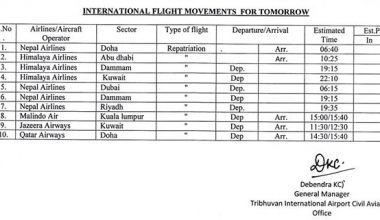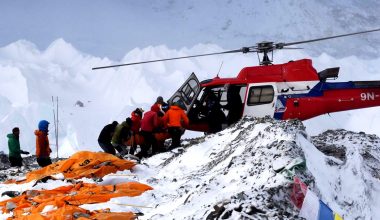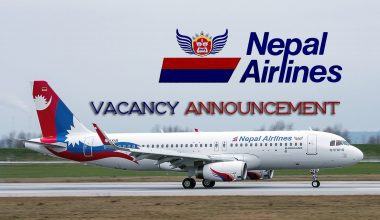-KATHMANDU
Ministry of Culture, Tourism and Civil Aviation (MoCTCA) with the support of Civil Aviation Authority of Nepal (CAAN) conducted workshop and seminar on ‘Air Transport Sector Reforms Initiatives in Nepal’ today at Hotel Radisson, Kathmandu.
The core aim of the seminar was to present 4 papers related to the reformation of Nepali Aviation industry and find out the lacking, solutions for the enhancement of air sector. Besides, seeking suggestions from aviation intellectuals/experts and discussing on infrastructural development of airport along with other 23 key agendas were the other significant part of the program today.
Honorable Minister for MoCTCA Mr. Rabindra Adhikari was the chief guest for the session. High level officials from CAAN, airline operators, aviation professionals and media personnel were the attendees of the workshop.
Minister Adhikari in his speech said that the enhancement of Tribhuvan International Airport (TIA) should be in the highest priority and healthy competitions must be maintained by private airlines for substantial growth in aviation market. “Airlines these days are focusing on providing services to trunk routes only due to the maximum revenue generation. This practice will grow the company but they must focus on providing services to the rural areas also”, he added.
Minister also discussed about the scientific management of air traffic at peak and lean hours. As TIA is already operational for 21 hours a day so, encouraging airlines to operate at lean hours with better airport facility is mandatory.
The four paper presentation was conducted in the gracious presence of Honorable Minster Adhikari. The first paper dealt with the airport infrastructure development, its utilization and human resource management. The paper discussed about the enhancement of Tribhuvan International Airport (TIA), requirements of additional international/domestic airports, reforms to be made for effective manpower, making air service accessible to everyone and air traffic congestion.
The second paper discussed about the airport operation and air transport economics. Likewise, the third paper was about Communication and Navigation System (CNS), Air Traffic Management (ATM), electromechanical system and modernization plan whereas the fourth paper presented institutionalization of Civil Aviation, its legal and safety aspects.
At present, there are 48 constructed airports in Nepal and 7 airports under construction. Out of 48, 16 are out of operation whereas 32 in operation however, 4 airports are generating significant loss. So, there will be no need of new domestic airports till 5 years of time as per the first presentation paper.
Likewise, it also stated that no more international airports will be required for next 30 to 40 years as Gautam Buddha International Airport (GBIA), Pokhara Regional International Airport and Second International Airport (SIA) projects are under way. GBIA is expected to operate after a year, Pokhara International Airport within 3 years and SIA project expected to require 10 years for completion.
As per the air traffic projection for next 20 years, the passengers’ movement is expected to increase from 6.57 million annually to 33.35 million annually by 2038. So, expansion of air transport sector is mandatory to handle such vigorous growth in passengers’ number. Nepal is 5th in the list of incoming tourists by airways. That’s why it’s a challenge for the regulatory body to provide consistent service to the increasing flow of passengers.
The international terminal building of TIA has the capacity to handle 3 million passengers annually but 3.89 million passengers were served in the year 2017. Likewise, domestic terminal can serve 0.5 million passengers whereas it served 2.45 million passengers in 2017 which is clearly beyond the capacity. This shows the urgency of air transport capacity enhancement at TIA and other airports around the country.
Persisting problems at TIA such as poor pavement of runway/taxiway, shorter parallel taxiway, one way traffic, lesser runway and taxiway separation, inappropriate geographical location for Instrumental Landing System (ILS) were also included. Aviation experts suggested CAT 1 GNSS (Global Navigation Satellite System), GBAS (Ground-Based Augmentation System)/SBAS (Satellite-based augmentation systems) for TIA along with satellite based navigation system and ADS-B (Automatic Dependent Surveillance-Broadcast) implementation. In addition, the presenters said that establishing a localizer/DME (Distance Measuring Equipment) at TIA would be fruitful for safe and effective flight operation.
The presentation also focused on installing Runway Center Line Light (RCLL) for TIA. Furthermore, procurement of 4 fire vehicles with rescue ladders was proposed to maintain CAT 9 standard at the sole international airport of the country. Aeronautical Ground Light installation for the domestic airports was also included in the agenda.
The process of splitting CAAN into two body; regulatory and air navigation services provider was also discussed at the meet today and it was informed that this action would help to improve the regulatory mechanism and also to develop civil aviation infrastructure however, no any effective approach has been made yet to do so.
Overall, the program highlighted the persisting problems of Nepalese aviation along with the meaningful suggestions and future plans to be executed for healthy growth. The Q&A session after each presentation was really productive as the questions raised by the delegates were strong enough to address the setbacks of Nepali aviation and also valuable for aviation experts’ think tank groups.







